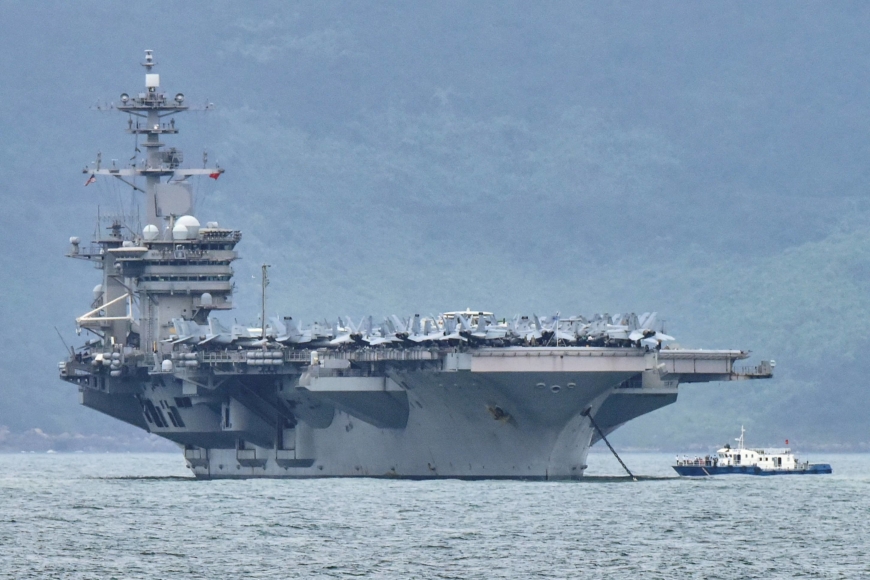[ad_1]
The U.S. military has slammed flights by Chinese warplanes in the disputed South China Sea last weekend that reportedly simulated a strike against the USS Theodore Roosevelt carrier strike group, but said that the exercise had posed no threat to the vessels.
Starting Jan. 23, the Chinese military flew a large number of warplanes, including nuclear-capable H-6K bombers and fighter jets into the southwest corner of Taiwan’s air defense identification zone (ADIZ). The timing coincided with the entry of the Roosevelt group into the South China Sea through the Bashi Channel, which separates Taiwan from the Philippines.
The Chinese warplanes’ flight may have been a response to the Roosevelt’s operations in the strategic waterway, some observers said, stoking concerns of the potential for a miscalculation erupting into conflict.
The Financial Times, citing regional intelligence sources, reported earlier this week that the Chinese warplanes had conducted a simulated strike against the carrier strike group.
“Pilots of H-6 bombers could be heard in cockpit conversations confirming orders for the simulated targeting and release of anti-ship missiles against the carrier,†the FT quoted the sources as saying.
A spokesman for the U.S. Indo-Pacific Command said he had no information on the reported cockpit conversations, but said the strike group was never at risk during the flights.
“The Theodore Roosevelt Carrier Strike Group closely monitored all People’s Liberation Army Navy (PLAN) and Air Force (PLAAF) activity, and at no time did they pose a threat to U.S. Navy ships, aircraft, or sailors,†U.S. Navy Capt. Mike Kafka said in a statement.
“However, the PLA activities highlighted here, are the latest in a string of aggressive and destabilizing actions,†Kafka added. “These actions reflect a continued PLA attempt to use its military as a tool to intimidate or coerce those operating in international waters and airspace,†including their neighbors and “those with competing territorial claims.â€

On Jan. 23, the Chinese military sent a fleet of 13 warplanes, including H-6K bombers, into the southwest corner of Taiwan’s ADIZ. A day later, it dispatched 15 planes, including 12 fighter jets to the area.
A U.S. defense source speaking on condition of anonymity told The Japan Times that the Chinese warplanes did not come within 250 nautical miles (463 km) of the U.S. vessels.
In August, China launched a series of ballistic missiles, including “carrier killer†weapons, into the South China Sea as part of integrated military exercises apparently simulating a strike on U.S. warships. At least two of the missiles reportedly hit moving ship targets in the waters, media reports later said.
Neither the U.S. nor Chinese military have confirmed the reports, but the anti-ship missiles are known to be some of the most potent anti-access/area-denial (A2/AD) weapons in the People’s Liberation Army’s arsenal.
Beijing claims some 90% of the South China Sea, through which trillions of dollars in trade flow every year, despite overlapping claims by others in the region, including Vietnam, Malaysia, the Philippines, Taiwan and Brunei. It has reclaimed and militarized a number of islands in the waters despite protests from other claimants and the United States.
The U.S. and Japan fear the Chinese-held outposts, some of which boast military-grade airfields and advanced weaponry, could be used to restrict free movement in an area that includes vital sea lanes.
The U.S. military has angered Beijing by regularly holding drills and conducting “freedom of navigation operations†(FONOPs) close to and over some of the islands there, including 10 last year.
The latest U.S. criticism of China’s military assertiveness comes after the Defense Ministry in Beijing on Thursday delivered some of its most overt remarks on Taiwan in months, saying “secession means war†and adding that the recent military drills near the island were “solemn responses to foreign interference and provocations by Taiwan separatist forces.â€
“We solemnly warn these Taiwan separatists: Those who play with fire will get burned, Taiwan secession means war,†Defense Ministry spokesman and Senior Col. Wu Qian said. “The People’s Liberation Army will take whatever actions necessary to resolutely thwart any secession schemes, and adamantly safeguard national sovereignty and territorial integrity.â€
Chinese state-run media promoted the remarks by the ministry, explicitly noting that the pointed threats of war over Taiwan were “exceedingly rare.â€
In a commentary on Friday, the state-run Global Times nationalist newspaper, called the warplanes’ flight a “message†to Taiwan and the U.S.
“Do not misjudge or underestimate the Chinese mainland’s determination and will to defend its territorial integrity and to severely punish the reckless acts of ‘Taiwan independence’ forces,†the editorial said. “If the island of Taiwan and the U.S. regard the previous U.S. administration’s last-minute acts as a new starting point of their ties and continue to promote ‘Taiwan independence,’ it is predictable that military conflicts will be triggered across the Taiwan Straits.
“This is not an empty threat,†it added.
In its waning days, the administration of President Donald Trump unleashed a series of moves to more tightly bind Washington’s ties with Taipei amid an increasingly acrimonious relationship with Beijing. These included the lifting of decades-old restrictions on contacts between U.S. officials and their Taiwanese counterparts.
In a time of both misinformation and too much information, quality journalism is more crucial than ever.
By subscribing, you can help us get the story right.
[ad_2]
Source link







